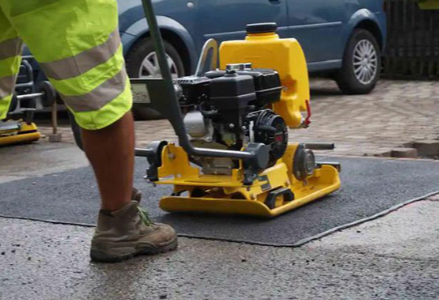Do I Need a Plate Compactor Instead of an Asphalt Tamper for Large Areas?

Introduction to Compaction Equipment
The question of whether to use a plate compactor or an asphalt tamper for large areas is one that many contractors, property owners, and construction professionals grapple with regularly. The decision between these two fundamental pieces of compaction equipment can significantly impact project efficiency, final quality, and overall costs. Understanding the nuances between these tools becomes even more critical when dealing with extensive areas where the wrong choice could result in substantial time delays, increased labor costs, and potentially subpar results.
Compaction equipment serves the essential purpose of removing air voids from materials like soil, gravel, sand, and asphalt, creating a stable, durable surface that can withstand traffic loads and environmental stresses. The effectiveness of this compaction process directly influences the longevity and performance of the finished surface, making equipment selection a crucial decision point in any construction or maintenance project.
When working with large areas, the stakes become even higher. The equipment choice affects not only the immediate project outcomes but also long-term maintenance requirements, project timelines, and labor allocation. A thorough understanding of both plate compactors and asphalt tampers, along with their respective strengths and limitations, provides the foundation for making informed decisions that align with project requirements and budget constraints.
Understanding Plate Compactors
Plate compactors represent a significant advancement in compaction technology, designed to deliver consistent, efficient compaction across various materials and project scales. These machines utilize a heavy steel plate that vibrates at high frequencies, typically ranging from 2,500 to 6,000 vibrations per minute, to achieve deep penetration and thorough compaction. The vibrating action breaks the bonds between particles and allows them to settle into a denser configuration, effectively reducing air voids and creating a stable foundation.
The design of plate compactors incorporates several key components that contribute to their effectiveness in large area applications. The base plate, usually constructed from heavy-duty steel, provides the primary compaction force and determines the coverage width with each pass. Modern plate compactors feature base plates ranging from 14 inches to over 30 inches in width, with larger plates naturally covering more ground per pass and reducing the total number of passes required for complete coverage.
The engine system in plate compactors typically consists of robust gasoline or diesel engines that provide the power necessary to generate consistent vibration patterns. These engines are designed for extended operation periods, making them well-suited for large projects that require hours of continuous operation. The vibration system, often incorporating eccentric weights or shafts, converts engine power into the specific vibration patterns that optimize compaction effectiveness.
Weight distribution plays a crucial role in plate compactor performance, with most units weighing between 90 and 750 pounds depending on their size and intended application. Heavier units provide greater compaction force but may be more challenging to maneuver in tight spaces or on steep grades. The weight-to-power ratio affects both compaction effectiveness and operational efficiency, with properly balanced units delivering optimal performance across various material types.
Advanced plate compactors often include features like reversible operation, which allows the machine to compact while moving both forward and backward, essentially doubling productivity and ensuring more thorough coverage. Water systems for dust suppression and material conditioning are common on units designed for extensive use, improving working conditions and compaction quality simultaneously.
Understanding Asphalt Tampers
Asphalt tampers, while more traditional in their approach, remain valuable tools in specific applications and continue to serve important roles in compaction work. These tools operate on a fundamentally different principle than plate compactors, relying primarily on impact force and weight rather than vibration to achieve compaction. The basic design consists of a heavy, flat-bottomed head attached to a handle, allowing operators to apply downward force through manual operation.
Traditional hand tampers typically weigh between 8 and 35 pounds, with the weight concentrated in the tamping head to maximize impact force. The tamping surface varies in size, generally ranging from 6 inches by 6 inches to 10 inches by 10 inches, providing a relatively small contact area that requires multiple impacts to achieve coverage comparable to larger compaction equipment.
The manual operation of asphalt tampers requires significant physical effort and creates inherent limitations in terms of coverage area and compaction consistency. Each impact delivers compaction force to a small area, requiring systematic overlapping to achieve complete coverage. This process becomes increasingly labor-intensive as project areas expand, making tampers less practical for extensive applications.
However, tampers excel in applications requiring precise control and careful material handling. The operator maintains direct control over compaction force and can adjust impact intensity based on material response and specific requirements. This level of control proves valuable in sensitive areas where over-compaction could cause problems or where access limitations prevent the use of larger equipment.
Pneumatic tampers represent an evolution of the traditional manual design, incorporating compressed air systems to reduce operator fatigue while maintaining the impact-based compaction principle. These tools deliver rapid, consistent impacts while requiring less physical effort from the operator, improving both productivity and working conditions compared to purely manual alternatives.
Key Differences Between Plate Compactors and Asphalt Tampers
The fundamental differences between plate compactors and asphalt tampers extend far beyond their basic operational mechanisms, encompassing factors that directly impact their suitability for large area applications. Understanding these distinctions provides the foundation for making informed equipment selection decisions based on project-specific requirements and constraints.
Coverage efficiency represents perhaps the most significant difference between these equipment types, particularly relevant when considering large area applications. Plate compactors typically cover 14 to 30 inches of width with each pass, while tampers impact areas measuring approximately 6 to 10 inches square with each blow. This difference translates to dramatic variations in productivity rates, with plate compactors potentially covering 10 to 20 times more area per unit of time compared to manual tampers.
The compaction mechanism itself creates distinct performance characteristics that affect material response and final quality. Plate compactors generate continuous vibration that penetrates deeply into materials, creating uniform density throughout the compacted layer. This vibration helps particles find optimal arrangements and eliminates air voids more effectively than impact-based methods. Tampers deliver discrete impact forces that compress materials through direct pressure, potentially creating less uniform density patterns and requiring more passes to achieve comparable results.
Power requirements and operational independence differ substantially between these equipment types. Plate compactors incorporate self-contained power systems that enable continuous operation without external power sources or frequent operator intervention. Tampers rely entirely on operator energy input, creating natural limitations on sustained operation periods and introducing variability based on operator fatigue and technique consistency.
Maneuverability and access capabilities present trade-offs between the two equipment types. Plate compactors, while more productive, require adequate space for operation and may struggle in extremely confined areas or around complex obstacles. Tampers offer superior access to tight spaces and precise control around delicate installations but sacrifice productivity for this flexibility.
When to Choose a Plate Compactor for Large Areas
Large area compaction projects present specific challenges and requirements that strongly favor plate compactor selection in most circumstances. The decision to use a plate compactor becomes increasingly compelling as project area increases, driven by fundamental advantages in productivity, consistency, and cost-effectiveness that compound with scale.
Project area threshold considerations typically begin favoring plate compactors when continuous compaction areas exceed approximately 500 square feet, though this threshold varies based on material type, required compaction standards, and project timelines. Areas measuring several thousand square feet or more almost universally benefit from plate compactor use, as the productivity advantages become overwhelming compared to manual alternatives.
Time efficiency gains represent one of the most compelling arguments for plate compactor selection in large projects. A typical plate compactor can achieve complete coverage of 1,000 square feet in 15 to 30 minutes, depending on material requirements and overlap patterns. Accomplishing the same coverage with manual tampers could require 4 to 8 hours of continuous operation, assuming no breaks for operator rest and recovery.
Labor cost considerations strongly favor plate compactors in large applications due to both reduced labor hours and decreased physical demands on workers. While plate compactor operation still requires skilled operators, the physical demands are significantly lower than manual tamping, reducing fatigue-related productivity losses and potential injury risks. The reduced labor hour requirements often offset equipment rental or purchase costs, particularly in projects spanning multiple days.
Consistency advantages become more pronounced in large areas where maintaining uniform compaction standards across the entire project becomes challenging with manual methods. Plate compactors deliver consistent vibration patterns and compaction force regardless of operator fatigue or technique variations, resulting in more uniform final surfaces and better long-term performance.
Material penetration depth capabilities make plate compactors superior for large areas requiring deep compaction or multiple lift construction. The continuous vibration can effectively compact layers up to 12 inches thick in suitable materials, while tampers typically achieve effective compaction in layers no thicker than 4 to 6 inches, requiring more lifts and additional material handling in deep applications.
When an Asphalt Tamper Might Still Be Suitable
Despite the general advantages of plate compactors for large areas, specific circumstances and project characteristics can still justify tamper selection or create situations where tampers serve as necessary supplements to larger equipment. Understanding these scenarios helps ensure appropriate equipment selection and optimal project outcomes.
Budget constraints represent the most common scenario where tampers might be selected over plate compactors, particularly for one-time projects or organizations with limited equipment budgets. While the productivity disadvantages are significant, the lower initial investment required for tamper purchase or rental can make them viable options when labor costs are relatively low or volunteer labor is available.
Access limitations within large project areas can create zones where tampers become necessary even when plate compactors handle the majority of the work. Areas around utilities, landscaping features, building foundations, or other obstacles may require the precision and compact size that tampers provide. In these situations, a combination approach using plate compactors for open areas and tampers for detail work often proves most effective.
Material sensitivity considerations sometimes favor tampers even in large applications. Certain materials or existing surface conditions may be damaged by the continuous vibration of plate compactors, requiring the controlled impact that tampers provide. Decorative surfaces, sensitive utilities, or materials prone to segregation under vibration may necessitate tamper use despite productivity disadvantages.
Quality control requirements in critical applications might justify tamper use to ensure precise compaction control. While less efficient, the direct operator control provided by tampers allows for immediate adjustment of compaction force based on material response, potentially achieving better results in challenging conditions or materials with variable properties.
Noise restrictions can influence equipment selection in urban environments or areas with strict noise ordinances. Tampers operate much more quietly than powered plate compactors, making them suitable for work in noise-sensitive areas during restricted hours. However, the extended operation time required for large areas may offset this advantage by prolonging the overall disturbance period.
Project Size Considerations
The relationship between project size and optimal equipment selection involves complex interactions between area coverage, project timeline, available resources, and quality requirements. Understanding these relationships helps establish clear guidelines for equipment selection while accounting for project-specific variables that may influence the decision.
Small project thresholds, typically involving areas under 200 square feet, often justify tamper use due to setup time considerations and equipment rental minimums. The time required to transport, set up, and operate a plate compactor may exceed the total project time achievable with tampers in very small applications. Additionally, minimum rental periods for powered equipment can make tampers more cost-effective for brief projects.
Medium-sized projects spanning 200 to 1,000 square feet represent a transitional zone where project-specific factors heavily influence equipment selection. Timeline requirements, available labor, access constraints, and quality standards all play significant roles in determining the optimal approach. Projects with generous timelines and available manual labor might successfully use tampers, while those with tight schedules or labor limitations benefit from plate compactor use.
Large project applications, encompassing areas over 1,000 square feet, almost universally benefit from plate compactor selection due to the compounding advantages in productivity, consistency, and cost-effectiveness. The break-even point for equipment costs occurs quickly in large applications, making plate compactors economically attractive even for organizations that don’t regularly perform compaction work.
Very large projects spanning tens of thousands of square feet may require multiple pieces of equipment or larger, more specialized compaction equipment beyond standard plate compactors. In these applications, the decision may involve selecting between different sizes and types of powered compaction equipment rather than choosing between powered and manual alternatives.
Cost Analysis and Budget Planning
Comprehensive cost analysis for compaction equipment selection must account for both direct equipment costs and indirect factors that significantly impact total project expenses. The apparent cost advantage of tampers often disappears when all relevant factors are considered, particularly in large area applications where indirect costs dominate total project expenses.
Equipment acquisition costs represent the most visible expense category, with manual tampers typically costing $50 to $200 for purchase or $15 to $30 per day for rental. Plate compactors require significantly higher initial investments, ranging from $200 to $500 per day for rental or $2,000 to $8,000 for purchase, depending on size and features. However, these direct equipment costs often represent a small fraction of total project expenses in large applications.
Labor cost calculations reveal the most significant economic impact of equipment selection in large projects. Manual tamping requires approximately 3 to 6 hours of labor per 1,000 square feet, depending on material type and compaction requirements. Plate compactor operation typically accomplishes the same coverage in 0.5 to 1 hour, creating labor cost savings that often exceed equipment cost differences by substantial margins.
Productivity considerations extend beyond simple labor hour calculations to include factors like operator fatigue, work quality consistency, and project scheduling flexibility. Manual tamping creates physical demands that may require multiple operators, rest periods, or reduced productivity rates over extended periods. Plate compactors maintain consistent productivity throughout operation periods, enabling better project scheduling and timeline predictability.
Hidden cost factors in large projects can significantly impact total project expenses regardless of initial equipment selection. Poor compaction quality resulting from inadequate equipment or operator fatigue can create long-term maintenance requirements, premature surface failure, or the need for remedial work. These potential costs often exceed initial equipment cost differences and strongly favor methods that ensure consistent, high-quality results.
Performance Factors in Large-Scale Projects
Performance optimization in large-scale compaction projects requires understanding how equipment characteristics interact with project variables to influence final outcomes. The performance advantages of different equipment types become more pronounced as project scale increases, creating clear preferences for specific applications and conditions.
Compaction effectiveness varies significantly between equipment types, with plate compactors generally achieving superior density and uniformity compared to manual methods. The continuous vibration generated by plate compactors helps materials achieve optimal particle arrangements and eliminates air voids more thoroughly than impact-based methods. This improved compaction translates to better long-term performance and reduced maintenance requirements in the finished surface.
Coverage uniformity presents particular challenges in large projects where maintaining consistent standards across extensive areas becomes difficult with manual methods. Operator fatigue, technique variations, and time pressures can create uneven compaction patterns that compromise overall surface quality. Plate compactors deliver consistent performance throughout operation periods, ensuring uniform compaction standards across entire project areas.
Depth penetration capabilities influence equipment selection in projects requiring deep compaction or multiple-lift construction. Plate compactors can effectively compact layers up to 12 inches thick in suitable materials, while manual tampers typically achieve effective results only in layers 4 to 6 inches thick. This difference affects material handling requirements and construction sequencing in deep applications.
Speed and efficiency factors become increasingly important as project areas expand. The productivity advantages of plate compactors compound with area increases, creating dramatic differences in project completion times. Projects that might require days of manual tamping can often be completed in hours with appropriate plate compactor equipment, enabling better project scheduling and resource allocation.
Equipment Selection Based on Material Type
Material characteristics significantly influence optimal compaction equipment selection, with different materials responding differently to various compaction methods. Understanding these material-specific requirements helps ensure appropriate equipment selection and optimal compaction results across different project applications.
Granular materials like gravel, crushed stone, and sand typically respond well to vibration-based compaction methods, making plate compactors highly effective for these applications. The vibration helps particles rearrange into denser configurations while maintaining good drainage characteristics. Manual tampers can achieve adequate results in granular materials but require significantly more effort and time to reach comparable density levels.
Cohesive materials including clay and silt present different compaction challenges that may influence equipment selection. While plate compactors remain effective for most cohesive materials, operator skill and moisture control become more critical factors in achieving optimal results. Over-compaction can create undesirable conditions in some cohesive materials, potentially favoring more controlled manual methods in sensitive applications.
Asphalt materials generally benefit from plate compactor use due to the uniform pressure distribution and consistent compaction force provided by the vibrating plate. The heat retention in asphalt during compaction makes quick, efficient compaction essential, strongly favoring methods that minimize compaction time. Manual tampers can be used for asphalt but require careful attention to material temperature and working time limitations.
Mixed materials and recycled aggregates often contain variable particle sizes and compositions that respond differently to various compaction methods. Plate compactors typically handle material variability better than manual methods, providing consistent compaction force regardless of local material variations. The penetration depth capabilities of plate compactors also help achieve uniform density in materials with significant size variations.
Professional vs DIY Considerations
The decision between professional contractor involvement and do-it-yourself approaches significantly influences equipment selection and project planning for large area compaction. Understanding the implications of each approach helps ensure realistic project planning and appropriate equipment selection based on available skills and resources.
Professional contractor advantages include access to appropriate equipment, experienced operators, and established procedures that optimize compaction results. Contractors typically own or have preferred rental arrangements for plate compactors and other specialized equipment, enabling cost-effective access to optimal tools for large projects. The experience and skill levels of professional operators often achieve better results in less time compared to inexperienced DIY efforts.
DIY project considerations must account for equipment learning curves, safety requirements, and time availability that may influence optimal equipment selection. While plate compactors are generally user-friendly, achieving optimal results requires understanding of compaction principles, material behavior, and equipment operation techniques. DIY operators may initially achieve better results with simpler equipment like tampers, despite productivity disadvantages.
Equipment rental and purchase decisions differ significantly between professional and DIY applications. Professionals often justify equipment purchases based on multiple project usage, while DIY users typically favor rental arrangements for occasional projects. However, large DIY projects may still justify plate compactor rental due to the significant time and effort savings compared to manual alternatives.
Training and safety requirements become more critical in DIY applications where operators may lack experience with powered compaction equipment. Plate compactors require understanding of proper operation techniques, safety procedures, and maintenance requirements that may not be immediately obvious to inexperienced users. Adequate training and preparation time must be factored into project planning for DIY applications.
Long-term Investment Perspective
Equipment investment decisions for compaction work should consider long-term usage patterns, maintenance requirements, and evolving project needs that influence total ownership costs and optimal equipment selection. Understanding these long-term factors helps ensure equipment choices align with broader organizational goals and usage patterns.
Usage frequency analysis helps determine whether equipment purchase or rental provides better long-term value. Organizations performing regular compaction work often justify plate compactor purchases due to the convenience, availability, and cost advantages of ownership compared to repeated rental fees. Occasional users typically find rental arrangements more cost-effective despite higher per-use costs.
Equipment versatility considerations favor plate compactors in most long-term investment scenarios due to their broader application range and superior performance in large projects. While the initial investment is higher, plate compactors can handle a wider variety of projects and materials compared to manual tampers, providing better long-term utility and investment return.
Maintenance and operating cost factors influence total ownership expenses and equipment selection decisions. Plate compactors require regular maintenance including engine service, vibration system inspection, and wear component replacement. However, the operating costs per square foot of coverage typically remain lower than manual labor costs, particularly when considering the productivity advantages and consistent results achieved.
Technology advancement and equipment obsolescence considerations suggest that plate compactor technology continues evolving with improved efficiency, reduced emissions, and enhanced features. Investing in quality plate compactor equipment typically provides better long-term value retention compared to basic manual tools that offer limited advancement potential.
Read Also: How to Edit Interview Footage: Techniques for a Natural Flow
Maintenance and Operational Considerations
Proper maintenance and operational procedures significantly impact equipment performance, longevity, and total project costs regardless of equipment selection. Understanding these requirements helps ensure optimal equipment performance and realistic cost projections for different compaction methods.
Plate compactor maintenance requirements include regular engine service, vibration system inspection, and base plate condition monitoring. Engine maintenance follows standard small engine service schedules with oil changes, air filter replacement, and spark plug service at recommended intervals. The vibration system requires periodic inspection of mounting bolts, eccentric weights, and bearing conditions to prevent failures that could result in costly repairs or project delays.
Operational best practices for plate compactors include proper startup and warm-up procedures, appropriate travel speeds, and systematic coverage patterns that ensure complete compaction without over-working materials. Understanding material-specific requirements and moisture conditions helps optimize compaction effectiveness while preventing equipment damage or poor results.
Tamper maintenance involves primarily keeping the tamping surface clean and checking handle integrity for manual units. Pneumatic tampers require additional maintenance of air supply systems, hoses, and impact mechanisms. While maintenance requirements are generally lower for tampers, their limited productivity means that maintenance downtime has less impact on overall project schedules.
Storage and transportation considerations differ significantly between equipment types. Plate compactors require secure transportation methods and proper storage conditions to protect engines and vibration systems from damage. Tampers are generally more portable and require less specialized storage, making them convenient for organizations with limited storage facilities or transportation capabilities.
Safety Factors in Large Area Compaction
Safety considerations in large area compaction projects encompass equipment-specific hazards, site conditions, and operational procedures that must be addressed regardless of equipment selection. Understanding these safety factors helps ensure appropriate equipment selection and proper safety planning for compaction operations.
Plate compactor safety requirements include protection from vibration exposure, noise levels, and potential equipment malfunctions. Operators should use appropriate personal protective equipment including hearing protection, safety glasses, and steel-toed boots. Understanding proper operating procedures and recognizing signs of equipment problems helps prevent accidents and injuries during operation.
Manual tamper safety focuses primarily on preventing repetitive stress injuries, back strain, and fatigue-related accidents. Proper lifting techniques, regular breaks, and rotation of operators help minimize injury risks during extended tamping operations. The physical demands of manual tamping may require multiple operators or shorter work periods compared to powered equipment.
Site safety considerations become more complex in large projects where extended operation periods and multiple workers create additional hazard potential. Establishing clear work zones, communication procedures, and emergency response plans helps ensure safe operations regardless of equipment selection. Dust control and material handling safety apply to all compaction methods but may require different approaches based on equipment capabilities.
Equipment-specific training requirements vary significantly between manual and powered equipment. While tamper operation is relatively straightforward, proper technique and safety awareness still require training and supervision. Plate compactor operation involves more complex procedures and safety considerations that require comprehensive training and ongoing supervision, particularly for inexperienced operators.
Conclusion and Final Recommendations
The decision between plate compactors and asphalt tampers for large area applications represents a clear choice in most circumstances, with plate compactors providing overwhelming advantages in productivity, consistency, and cost-effectiveness. The analysis of coverage efficiency, labor requirements, quality outcomes, and total project costs consistently favors plate compactor selection for projects exceeding 500 to 1,000 square feet in area.
The productivity advantages of plate compactors become increasingly compelling as project size increases, with coverage rates 10 to 20 times higher than manual tampers creating dramatic differences in project completion times and labor costs. These efficiency gains typically offset the higher equipment costs within the first few hundred square feet of coverage, making plate compactors economically attractive even for organizations that perform compaction work infrequently.
Quality and consistency benefits provide additional justification for plate compactor selection in large projects where maintaining uniform standards across extensive areas becomes challenging with manual methods. The consistent vibration patterns and compaction force delivered by plate compactors result in more uniform final surfaces and better long-term performance compared to manual alternatives that may suffer from operator fatigue and technique variations.
However, specific project circumstances may still justify tamper use or create situations where combinations of both equipment types provide optimal results. Access limitations, budget constraints, material sensitivity, or noise restrictions can influence equipment selection decisions and may require creative approaches to achieve project objectives within given constraints.
For most large area compaction applications, the recommendation strongly favors plate compactor selection due to the compelling advantages in efficiency, quality, and cost-effectiveness. Organizations should consider plate compactor rental or purchase as a worthwhile investment that pays dividends through improved productivity and results. When budget or access constraints prevent plate compactor use, careful planning and realistic timeline expectations become essential for successful project completion with manual alternatives.
The investment in proper equipment selection for large area compaction projects ultimately determines project success, worker satisfaction, and long-term surface performance. While the initial cost difference between equipment options may seem significant, the total project benefits of appropriate equipment selection far exceed these initial costs and justify careful consideration of all relevant factors in the decision-making process.
Certified Material Testing Products (Certified MTP) is a leading supplier of construction materials testing equipment and laboratory supplies in the United States. They offer a comprehensive range of products for testing concrete, asphalt, aggregate, soil, and cement, catering to both field and laboratory applications But no matter whether they are preferred or not, the whole idea behind these tools is similar: getting a polished, shiny, and permanent effect. New to stucco or a seasoned pro, investing in good tools and learning the nuances of their use is what will get you started perfecting your craft.
Frequently Asked Questions
Q: What is the minimum area size that justifies using a plate compactor over a tamper?
A: Generally, areas exceeding 500 square feet begin to favor plate compactor use due to productivity advantages. However, the break-even point depends on factors like available labor costs, project timeline, and rental rates in your area. For areas over 1,000 square feet, plate compactors are almost universally more cost-effective.
Q: Can I achieve the same quality results with a tamper as with a plate compactor?
A: While skilled operators can achieve good results with tampers, plate compactors typically provide more consistent and uniform compaction. The continuous vibration penetrates deeper and eliminates air voids more effectively than impact-based tamping. For critical applications requiring high-quality, uniform results, plate compactors are generally superior.
Q: How much faster is a plate compactor compared to manual tamping?
A: Plate compactors typically cover areas 10 to 20 times faster than manual tampers. A 1,000 square foot area that might take 4 to 8 hours with a tamper can often be completed in 30 minutes to 1 hour with a plate compactor, depending on material requirements and overlap patterns.
Q: Are there situations where tampers are better than plate compactors even in large areas?
A: Yes, several situations may favor tampers: extremely tight spaces where plate compactors cannot access, noise-restricted environments, materials sensitive to vibration, applications requiring precise control of compaction force, or when budget constraints prevent plate compactor rental or purchase.
Q: What are the typical rental costs for plate compactors vs tampers?
A: Manual tampers typically rent for $15 to $30 per day, while plate compactors range from $200 to $500 per day depending on size. However, the higher productivity of plate compactors often makes them more cost-effective despite higher rental rates, especially when labor costs are considered.
Q: Do I need special training to operate a plate compactor?
A: While plate compactors are generally user-friendly, proper operation does require understanding of startup procedures, travel speeds, overlap patterns, and safety requirements. Most rental companies provide basic operation instructions, but first-time users should allow time for learning and practice to achieve optimal results.
Q: Can plate compactors work on all the same materials as tampers?
A: Plate compactors are suitable for most materials that tampers can handle, including soil, gravel, sand, and asphalt. However, some sensitive materials or existing surfaces might be damaged by continuous vibration, potentially requiring the more controlled impact that tampers provide.
Q: How do I determine if my project area is too large for tamper use?
A: Consider factors like available time, labor costs, quality requirements, and physical demands. If the project would require more than one full day of tamping, involves multiple operators due to fatigue concerns, or has strict quality standards, a plate compactor likely provides better value despite higher equipment costs.
Q: What maintenance is required for plate compactors during large projects?
A: During operation, check engine oil levels, ensure proper fuel supply, and monitor for unusual vibrations or noises. Keep the base plate clean and inspect mounting bolts periodically. For multi-day projects, follow manufacturer recommendations for engine maintenance and allow proper warm-up and cool-down periods. For more Any Business Card, check out this guide from NFC Business Card Temperature corrections for measuring equipment become particularly important during extreme weather conditions. Ensure that pallet sizes and shelf depths are compatible with your handling equipment.
Q: Is it worth buying a plate compactor for occasional large projects?
A: Purchase decisions depend on usage frequency and storage capabilities. If you expect to use the equipment multiple times per year or have ongoing maintenance needs, purchase may be justified. For occasional use, rental typically provides better value while ensuring access to well-maintained, current equipment.





